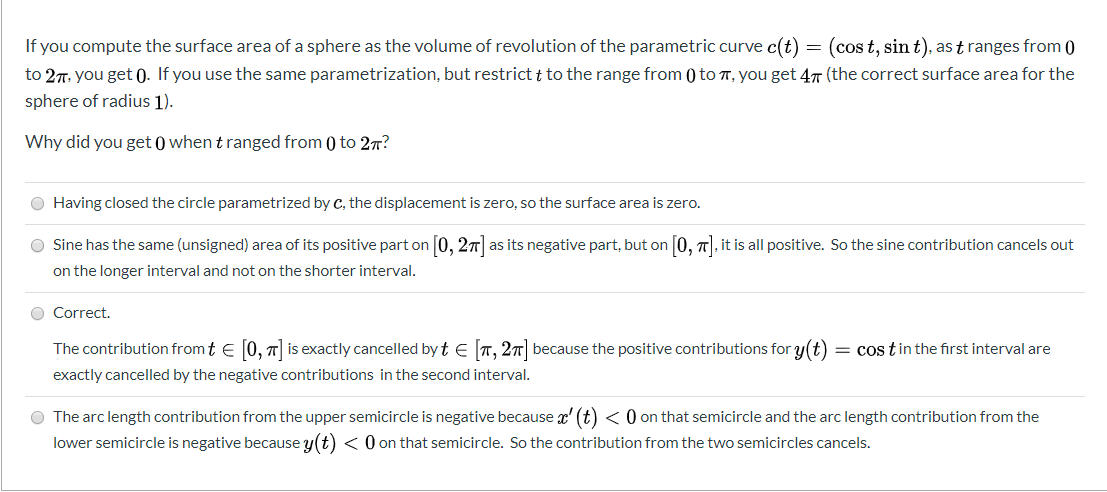If you compute the surface area of a sphere as the volume of revolution of the parametric curve c(t) = (cos t, sin t), as t ranges from 0 to 27. you get 0. If you use the same parametrization, but restrict t to the range from () to T, you get 47 (the correct surface area for the sphere of radius 1). Why did you get 0 when t ranged from () to 27? O Having closed the circle parametrized by c, the displacement is zero, so the surface area is zero. O Sine has the same (unsigned) area of its positive part on 0, 27 as its negative part, but on 0, 7|, it is all positive. So the sine contribution cancels out on the longer interval and not on the shorter interval. O Correct. The contribution from t e [0, 7| is exactly cancelled by t e T, 27| because the positive contributions for y(t) = cos tin the first interval are exactly cancelled by the negative contributions in the second interval. O The arc length contribution from the upper semicircle is negative because x' (t) < 0 on that semicircle and the arc length contribution from the lower semicircle is negative because y(t) < 0 on that semicircle. So the contribution from the two semicircles cancels.
If you compute the surface area of a sphere as the volume of revolution of the parametric curve c(t) = (cos t, sin t), as t ranges from 0 to 27. you get 0. If you use the same parametrization, but restrict t to the range from () to T, you get 47 (the correct surface area for the sphere of radius 1). Why did you get 0 when t ranged from () to 27? O Having closed the circle parametrized by c, the displacement is zero, so the surface area is zero. O Sine has the same (unsigned) area of its positive part on 0, 27 as its negative part, but on 0, 7|, it is all positive. So the sine contribution cancels out on the longer interval and not on the shorter interval. O Correct. The contribution from t e [0, 7| is exactly cancelled by t e T, 27| because the positive contributions for y(t) = cos tin the first interval are exactly cancelled by the negative contributions in the second interval. O The arc length contribution from the upper semicircle is negative because x' (t) < 0 on that semicircle and the arc length contribution from the lower semicircle is negative because y(t) < 0 on that semicircle. So the contribution from the two semicircles cancels.
Intermediate Algebra
10th Edition
ISBN:9781285195728
Author:Jerome E. Kaufmann, Karen L. Schwitters
Publisher:Jerome E. Kaufmann, Karen L. Schwitters
Chapter8: Conic Sections
Section8.2: More Parabolas And Some Circles
Problem 63.1PS
Related questions
Question

Transcribed Image Text:If you compute the surface area of a sphere as the volume of revolution of the parametric curve c(t) = (cos t, sin t), as t ranges from 0
to 27. you get 0. If you use the same parametrization, but restrict t to the range from () to T, you get 47 (the correct surface area for the
sphere of radius 1).
Why did you get 0 when t ranged from () to 27?
O Having closed the circle parametrized by c, the displacement is zero, so the surface area is zero.
O Sine has the same (unsigned) area of its positive part on 0, 27 as its negative part, but on 0, 7|, it is all positive. So the sine contribution cancels out
on the longer interval and not on the shorter interval.
O Correct.
The contribution from t e [0, 7| is exactly cancelled by t e T, 27| because the positive contributions for y(t)
= cos tin the first interval are
exactly cancelled by the negative contributions in the second interval.
O The arc length contribution from the upper semicircle is negative because x' (t) < 0 on that semicircle and the arc length contribution from the
lower semicircle is negative because y(t) < 0 on that semicircle. So the contribution from the two semicircles cancels.
Expert Solution
This question has been solved!
Explore an expertly crafted, step-by-step solution for a thorough understanding of key concepts.
Step by step
Solved in 3 steps with 3 images

Recommended textbooks for you

Intermediate Algebra
Algebra
ISBN:
9781285195728
Author:
Jerome E. Kaufmann, Karen L. Schwitters
Publisher:
Cengage Learning

Algebra & Trigonometry with Analytic Geometry
Algebra
ISBN:
9781133382119
Author:
Swokowski
Publisher:
Cengage

Intermediate Algebra
Algebra
ISBN:
9781285195728
Author:
Jerome E. Kaufmann, Karen L. Schwitters
Publisher:
Cengage Learning

Algebra & Trigonometry with Analytic Geometry
Algebra
ISBN:
9781133382119
Author:
Swokowski
Publisher:
Cengage